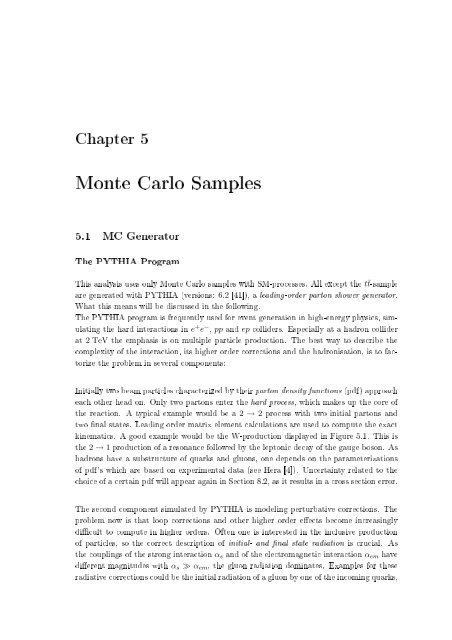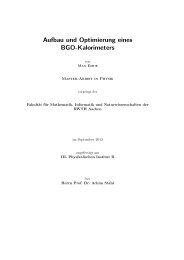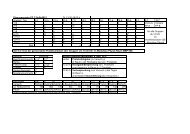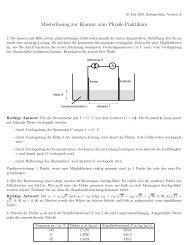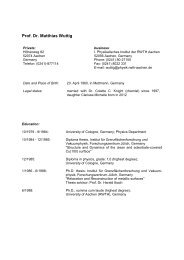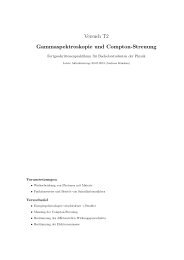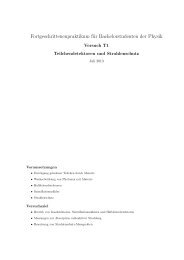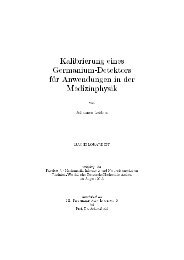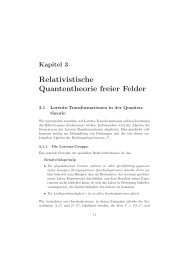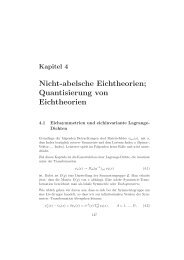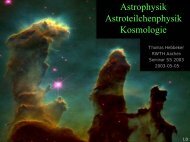Model Independent Search for Deviations from the Standard Model ...
Model Independent Search for Deviations from the Standard Model ...
Model Independent Search for Deviations from the Standard Model ...
Create successful ePaper yourself
Turn your PDF publications into a flip-book with our unique Google optimized e-Paper software.
Chapter 5<br />
Monte Carlo Samples<br />
5.1 MC Generator<br />
The PYTHIA Program<br />
This analysis uses only Monte Carlo samples with SM-processes. All except <strong>the</strong> t¯t-sample<br />
are generated with PYTHIA (versions: 6.2 [41]), a leading-order parton shower generator.<br />
What this means will be discussed in <strong>the</strong> following.<br />
The PYTHIA program is frequently used <strong>for</strong> event generation in high-energy physics, simulating<br />
<strong>the</strong> hard interactions in e + e , − pp and ep colliders. Especially at a hadron collider<br />
at 2 TeV <strong>the</strong> emphasis is on multiple particle production. The best way to describe <strong>the</strong><br />
complexity of <strong>the</strong> interaction, its higher order corrections and <strong>the</strong> hadronisation, is to factorize<br />
<strong>the</strong> problem in several components:<br />
Initially two beam particles characterized by <strong>the</strong>ir parton density functions (pdf) approach<br />
each o<strong>the</strong>r head on. Only two partons enter <strong>the</strong> hard process, which makes up <strong>the</strong> core of<br />
<strong>the</strong> reaction. A typical example would be a 2 → 2 process with two initial partons and<br />
two nal states. Leading order matrix element calculations are used to compute <strong>the</strong> exact<br />
kinematics. A good example would be <strong>the</strong> W-production displayed in Figure 5.1. This is<br />
<strong>the</strong> 2 → 1 production of a resonance followed by <strong>the</strong> leptonic decay of <strong>the</strong> gauge boson. As<br />
hadrons have a substructure of quarks and gluons, one depends on <strong>the</strong> parameterizations<br />
of pdf's which are based on experimental data (see Hera [4]). Uncertainty related to <strong>the</strong><br />
choice of a certain pdf will appear again in Section 8.2, as it results in a cross section error.<br />
The second component simulated by PYTHIA is modeling perturbative corrections. The<br />
problem now is that loop corrections and o<strong>the</strong>r higher order eects become increasingly<br />
dicult to compute in higher orders. Often one is interested in <strong>the</strong> inclusive production<br />
of particles, so <strong>the</strong> correct description of initial- and nal state radiation is crucial. As<br />
<strong>the</strong> couplings of <strong>the</strong> strong interaction α s and of <strong>the</strong> electromagnetic interaction α em have<br />
dierent magnitudes with α s ≫ α em , <strong>the</strong> gluon radiation dominates. Examples <strong>for</strong> <strong>the</strong>se<br />
radiativecorrectionscouldbe<strong>the</strong>initialradiationofagluonbyoneof<strong>the</strong>incomingquarks,


